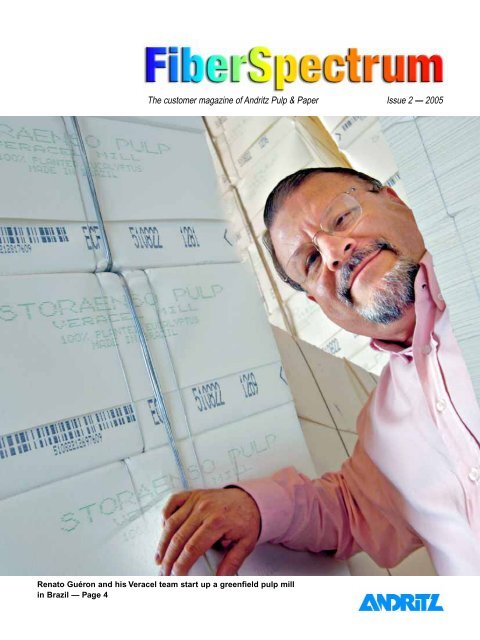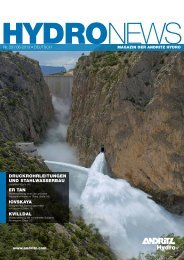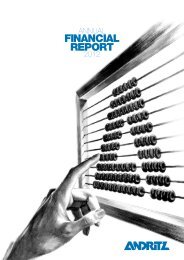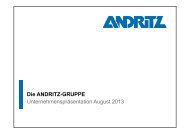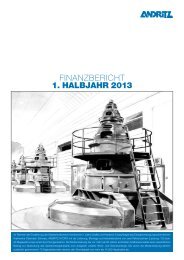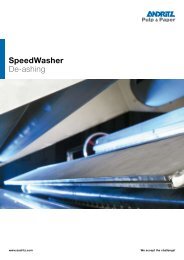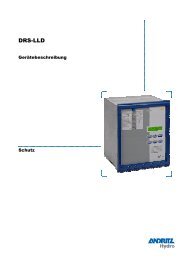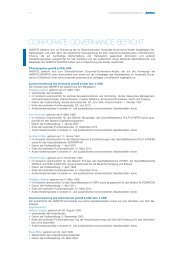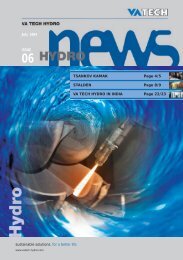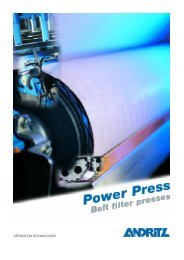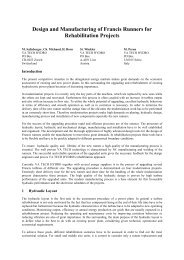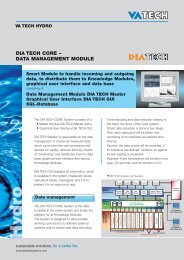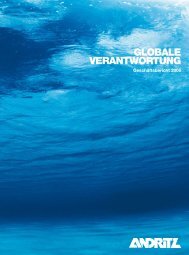The customer magazine of Andritz Pulp & Paper Issue 2 — 2005
The customer magazine of Andritz Pulp & Paper Issue 2 — 2005
The customer magazine of Andritz Pulp & Paper Issue 2 — 2005
You also want an ePaper? Increase the reach of your titles
YUMPU automatically turns print PDFs into web optimized ePapers that Google loves.
<strong>The</strong> <strong>customer</strong> <strong>magazine</strong> <strong>of</strong> <strong>Andritz</strong> <strong>Pulp</strong> & <strong>Paper</strong> <strong>Issue</strong> 2 <strong>—</strong> <strong>2005</strong><br />
Renato Guéron and his Veracel team start up a greenfield pulp mill<br />
in Brazil <strong>—</strong> Page 4
Contents<br />
3 <strong>Pulp</strong> & <strong>Paper</strong><br />
FiberSpectrum is published by:<br />
<strong>Andritz</strong> AG<br />
Stattegger Strasse 18<br />
A-8045 Graz, Austria<br />
Tel: +43 316 6902 0<br />
pulpandpaper@andritz.com<br />
Managing Editor:<br />
Manuela Wagner<br />
manuela.wagner@andritz.com<br />
Editor:<br />
Robert Puhr<br />
robert.puhr@andritz.com<br />
Editorial Team:<br />
Regina Edelmayer<br />
Bjørn Hansen<br />
Minna Heinonen<br />
Sara Koller<br />
Katri Lindstrom<br />
Mia Passi<br />
Brigitte Poms<br />
2 FiberSpectrum <strong>Issue</strong> 2 <strong>—</strong> <strong>2005</strong><br />
M A G A Z I N E<br />
4 Single-line success<br />
Veracel Celulose starts up huge greenfield mill in Brazil<br />
10 Boosting performance in Portugal<br />
Portucel Soporcel benefits from new recovery boiler<br />
12 Having it both ways<br />
Cartiere del Polesine lowers costs, improves quality <strong>of</strong> recycled fiber<br />
16 From cotton field to greenfield<br />
SCA Tissue’s new mill in Barton is a showcase <strong>of</strong> efficiency<br />
20 Room to grow<br />
Jiangxi Chenming improves woodyard and BTMP operations<br />
24 Innovative spiral improves papermaking<br />
New refiner plate design ups fiber quality and decreases energy<br />
cost in stock refining<br />
28 News from the world <strong>of</strong> <strong>Andritz</strong><br />
Contributing Writers:<br />
Michael Bohr<br />
Robert Puhr<br />
Robert Ryan<br />
Jonathan Roberts<br />
Martin Swayne<br />
Contributing Photographers:<br />
Bildhauer/3D Media<br />
Michael Bohr<br />
Croce & Wir<br />
Jorge Dias<br />
Tom Grow<br />
Katherina Hesse<br />
Robert Puhr<br />
Robert Ryan<br />
Timo Vesterinen<br />
Graphic Design:<br />
Morrison Graphic Design<br />
mdesign@logical.net<br />
You will see the use <strong>of</strong> both “tonnes” and “tons” in this publication: tonnes for metric units<br />
and tons for American units. Unless otherwise noted, metric units are used.<br />
Copyright © <strong>Andritz</strong> AG <strong>2005</strong>. All rights reserved.<br />
No part <strong>of</strong> this publication may be reproduced without permission <strong>of</strong> the publisher.<br />
Veracel plants some 17 million<br />
eucalyptus seedlings each year.<br />
In addition, 250,000 seedlings from<br />
more than 350 species are planted<br />
in 90,000 ha <strong>of</strong> protection zones<br />
for the recovery <strong>of</strong> native forests.<br />
Each eucalyptus seedling starts<br />
its life as a clone <strong>—</strong> hand cut,<br />
hand planted, and lovingly cared<br />
for in Veracel's nursery until it<br />
reaches about 60-70 cm in height.
Low-tech? No way.<br />
<strong>The</strong> average person may appreciate the crisp<br />
color graphics on a sheet <strong>of</strong> paper, but has no<br />
appreciation for the fibers and the technologies<br />
required to make that sheet <strong>of</strong> paper possible.<br />
<strong>Pulp</strong> & <strong>Paper</strong> may be one <strong>of</strong> the world’s<br />
“basic” industries <strong>—</strong> but basic can also mean<br />
vital. <strong>The</strong> European Union's Sixth Framework<br />
Programme (FP6), the main body for funding<br />
research in Europe, lists seven priority<br />
themes. You might be surprised to learn that<br />
five <strong>of</strong> the seven "priority technologies" are<br />
already being developed and utilized in the<br />
<strong>Pulp</strong> & <strong>Paper</strong> industry:<br />
Biotechnology. Forest tree biotechnology<br />
and clonal propagation in plantations. (<strong>The</strong><br />
article starting on Page 4 <strong>of</strong> this issue mentions<br />
this.) <strong>The</strong> utilization <strong>of</strong> enzymes in fiber<br />
processing and bleaching. Reduction <strong>of</strong><br />
organochlorine compounds in effluents. <strong>The</strong>re<br />
is a huge body <strong>of</strong> knowledge being developed<br />
in <strong>Pulp</strong> & <strong>Paper</strong> companies and suppliers like<br />
<strong>Andritz</strong>.<br />
Information Technology. <strong>The</strong>re is extensive<br />
use <strong>of</strong> IT throughout forest products companies.<br />
Order processing and production<br />
planning. In-mill process control and asset<br />
management systems. Sophisticated simulation<br />
for mill construction and start-ups (such as<br />
IDEAS Simulation by <strong>Andritz</strong>). Also, end products<br />
such as "smart" papers can integrate into<br />
the digital world (e.g. RFID technology).<br />
Nanotechnology. Designing components<br />
that are about 10,000<br />
times smaller than a<br />
s<strong>of</strong>twood pulp fiber!<br />
Nanotechnology's<br />
impact will extend<br />
beyond today's papermaking<br />
issues. "Selfassembling"nanocoatings<br />
will provide low-<br />
Markku Hänninen<br />
Member <strong>of</strong> Executive Board<br />
Head <strong>of</strong> <strong>Pulp</strong> Mill Technologies<br />
markku.hanninen@andritz.com<br />
<strong>Pulp</strong>&<strong>Paper</strong><br />
cost ways to make coated paper without<br />
extensive pressing and calendering.<br />
Food quality and safety. Nanotechnology<br />
enables the creation <strong>of</strong> "programmable" coatings.<br />
An example might be self-cleaning surfaces<br />
that destroy fungi and bacteria. Security<br />
paper can have advanced safety features that<br />
highlight tampering. Fiber engineering with<br />
<strong>Andritz</strong> systems ensure the correct fiber for<br />
each application.<br />
Sustainable development. Today, about<br />
50% <strong>of</strong> the total furnish is recycled fiber. New<br />
systems for energy recovery and reuse, the<br />
production <strong>of</strong> bi<strong>of</strong>uels, and the production <strong>of</strong><br />
biocomposites from nanocellulose and biopolymers<br />
(like lignin or dissolved pulp) all<br />
show great promise for achieving a sustainable<br />
global industry.<br />
Young graduates from engineering and technical<br />
programs tend to gravitate to the more<br />
"glamorous" employers. Based upon the<br />
above, the <strong>Pulp</strong> & <strong>Paper</strong> industry can be quite<br />
glamorous, too.<br />
We see this in our own recruiting efforts <strong>—</strong><br />
especially in the growth regions such as Asia,<br />
Latin America, and Russia. Young people love<br />
these new technical challenges. <strong>The</strong> <strong>Pulp</strong> &<br />
<strong>Paper</strong> industry is, and can continue to be, an<br />
exciting place to work. Our investments in<br />
recruiting and developing these bright minds<br />
will yield the technologies <strong>of</strong> tomorrow.<br />
Hopefully, this issue <strong>of</strong> FiberSpectrum will<br />
arrive on your desk<br />
right before the holiday<br />
season. We wish you<br />
a happy and safe holiday<br />
<strong>—</strong> and we look<br />
forward to working with<br />
you in the New Year.<br />
Bernhard Rebernik<br />
Member <strong>of</strong> Executive Board<br />
Head <strong>of</strong> <strong>Paper</strong> Mill Technologies<br />
bernhard.rebernik@andritz.com<br />
<strong>Issue</strong> 2 <strong>—</strong> <strong>2005</strong> FiberSpectrum 3
Veracel Celulose<br />
Single-line success<br />
<strong>The</strong> Veracel mill was completed ahead <strong>of</strong> schedule and under budget.<br />
Considering that it was built in a region with no infrastructure, and<br />
there were no local industries from which to draw technically trained<br />
employees <strong>—</strong> the 900,000 t/a pulp mill is a modern-day marvel.<br />
Walter Martins took a few steps forward,<br />
circled to take in a 360º view, and paused.<br />
"Considering that 24 months ago we<br />
would have been standing in a pasture<br />
in southern Bahia state, I think this is a<br />
pretty remarkable accomplishment."<br />
<strong>The</strong> accomplishment that Martins<br />
refers to is a gleaming, new pulp mill<br />
known as Veracel. When fully ramped<br />
up, the Veracel mill will produce in<br />
excess <strong>of</strong> 900,000 t/a <strong>of</strong> bleached eucalyptus<br />
pulp, according to Martins, who is<br />
4 FiberSpectrum <strong>Issue</strong> 2 <strong>—</strong> <strong>2005</strong><br />
Industrial Director. Half <strong>of</strong> the mill's production<br />
goes to Stora Enso for internal<br />
consumption and half goes to Aracruz's<br />
market pulp <strong>customer</strong>s around the world.<br />
<strong>The</strong> Veracel site is no longer a pasture.<br />
Today, the mill complex is ringed<br />
by 76,000 ha <strong>of</strong> managed eucalyptus<br />
plantations and 90,000 ha <strong>of</strong> original<br />
bio-diverse vegetation in which the<br />
company has planted additional native<br />
species to help restore the Mata<br />
Atlantica forest in the area. <strong>The</strong> forest<br />
was virtually eliminated by settlers<br />
and farmers well before<br />
the mill was even conceived <strong>of</strong>.<br />
First a road, then a mill<br />
In 2003, the Veracel Board<br />
approved the project and purchase<br />
orders were delivered to<br />
the suppliers <strong>of</strong> the key "packages"<br />
in the mill: ranging from<br />
the woodyard to the water/effluent<br />
systems. Seventeen<br />
months later, the mill was in<br />
start-up phase.<br />
Actually, when the Veracel<br />
project was approved, there<br />
was no infrastructure at the<br />
site. So, the first step was to<br />
build an access road from the<br />
main highway about 45 km<br />
away. Next came electricity<br />
and water.<br />
Walter Martins,<br />
Industrial Director <strong>of</strong> Veracel.<br />
<strong>The</strong> construction <strong>of</strong> Veracel mobilized<br />
around 6000 workers to the site. <strong>The</strong>re<br />
was very little industry in the area, so<br />
Veracel had to train workers in various<br />
skills such as carpentry, pipefitting, welding,<br />
and electrical work for the project.<br />
EPC suppliers as partners<br />
"<strong>The</strong> contracts with the suppliers were<br />
written on an EPC basis," says Renato<br />
Guéron <strong>of</strong> Veracel. Guéron was the<br />
Project Director and now is President<br />
<strong>of</strong> Veracel. "We started using EPC<br />
while I was at Aracruz, and we are<br />
improving upon the concept every time<br />
we do a project."<br />
As an EPC supplier, <strong>Andritz</strong> took<br />
responsibility for four <strong>of</strong> Veracel's packages:<br />
Cooking/Washing, Bleaching,<br />
Drying/Baling, and Causticizing/Lime Kiln.
"In an EPC delivery, <strong>Andritz</strong> is much<br />
more than just a vendor <strong>of</strong> equipment,"<br />
Guéron says. "<strong>The</strong>y have overall<br />
responsibility for achieving the performance<br />
<strong>of</strong> what was sold to us, not just<br />
delivering the equipment and supervision.<br />
<strong>The</strong>y really behaved as a partner<br />
and took their responsibilities seriously."<br />
Training and simulation<br />
"Although we brought together a team <strong>of</strong><br />
experienced people from other Brazilian<br />
mills, we also have a considerable group<br />
<strong>of</strong> young people," says Martins. "So, we<br />
have some very experienced pulp producers<br />
acting as coaches and teachers<br />
for this younger group who will take over<br />
in the next two years."<br />
<strong>The</strong> new fiberline from <strong>Andritz</strong><br />
is among the world's largest <strong>—</strong><br />
producing 900,000 t/a <strong>of</strong><br />
high-brightness (up to 92 ISO),<br />
high-strength eucalyptus pulp.<br />
Martins was responsible<br />
for coordination <strong>of</strong> training <strong>of</strong><br />
the mill operations people <strong>—</strong><br />
a process that took about<br />
one year.<br />
After nine months <strong>of</strong><br />
classroom training and then<br />
hands-on training at the<br />
Aracruz mill, the young operators<br />
were trained using the<br />
IDEAS Dynamic Simulator.<br />
"I don't see any possibility for<br />
a new big mill to be installed<br />
in the future without the use<br />
<strong>of</strong> a Dynamic Simulator,"<br />
Guéron says. "If I were to<br />
calculate the payback, I<br />
would think that the Simulator<br />
pays for itself within the first<br />
few days <strong>of</strong> operation."<br />
Renato Guéron, President <strong>of</strong> Veracel (left), with Siegfried Baumann, <strong>Andritz</strong>’s<br />
Project Director for the pulp drying/baling plant. <strong>Andritz</strong> was chosen as a<br />
"Perfect Partner" for its excellent execution <strong>of</strong> the pulp drying and baling project.<br />
Quality targets<br />
achieved early<br />
Veracel first put chips to the<br />
<strong>Andritz</strong> fiberline in May <strong>2005</strong>.<br />
“When it comes to pulp quality,<br />
we are very proud to have<br />
reached the our targets for<br />
strength, brightness, and<br />
cleanliness already in July,”<br />
Guéron says. “<strong>The</strong>se were<br />
targets that were established<br />
at the beginning <strong>of</strong> the project.”<br />
With quality established, the<br />
mill is began quickly climbing<br />
its “production learning<br />
curve” according to Guéron.<br />
<strong>Issue</strong> 2 <strong>—</strong> <strong>2005</strong> FiberSpectrum 5
Up the learning curve<br />
<strong>The</strong> mill successfully mastered its<br />
production learning curve, Guéron<br />
says, on November 6, <strong>2005</strong> by<br />
running 30 consecutive days at an<br />
average daily production equal to<br />
the design capacity <strong>of</strong> the mill<br />
(2543 t/d <strong>of</strong> pulp). “Many times<br />
we have produced over design<br />
capacity,” he says. “<strong>The</strong> highest<br />
single day <strong>of</strong> production has been<br />
3220 tonnes.”<br />
<strong>The</strong> original timeline for mastering<br />
the curve was 12 months into<br />
start-up. “However, due to the good<br />
results we were experiencing,”<br />
Guéron explains, “we shortened our<br />
time frame. In the end, we were able<br />
to do it 174 days after start-up <strong>—</strong><br />
just less than six months.”<br />
SUSTAINABLE<br />
FORESTRY:<br />
a key competence<br />
for Veracel<br />
6 FiberSpectrum <strong>Issue</strong> 2 <strong>—</strong> <strong>2005</strong><br />
Guilherme Araujo, Fiberline Manager<br />
<strong>Andritz</strong> single-line<br />
"We have the most important areas<br />
<strong>of</strong> the mill supplied by <strong>Andritz</strong>,"<br />
Guéron says. "We have had very<br />
good cooperation and the equipment<br />
itself is top quality. That is<br />
exactly what we were after when<br />
we made our selections in 2003."<br />
"<strong>The</strong>re was a time when no mill<br />
would take the risk <strong>of</strong> having one<br />
large piece <strong>of</strong> equipment," Guéron<br />
says. "<strong>The</strong>y would build-in redundancy<br />
with at least two <strong>of</strong> everything.<br />
Also, the owner had to blend systems<br />
from different suppliers since<br />
one was good in cooking, another<br />
good in washing, another good in<br />
bleaching. Today, the major suppliers<br />
are good in all the processes,<br />
so a single line is possible."<br />
FiberSpectrum managed to get a few moments with Antônio Sergio Alipio, Forestry<br />
Director <strong>of</strong> Veracel. Alipio is a very busy man managing an organization <strong>of</strong> 2400<br />
forestry workers and helping local farmers to establish plantations as a future fiber<br />
source for the mill. <strong>The</strong> following is a condensed version <strong>of</strong> his comments.<br />
“Brazil has some <strong>of</strong> the most productive forests in the world, and Bahia has the most<br />
productive in Brazil. <strong>The</strong> average for Brazil is 30 m 3 /ha/a (compared to 5 m 3 /ha/a in<br />
Finland), and here in Bahia we average about 50 m 3 /ha/a. Wood transportation is<br />
about 1/3 <strong>of</strong> our total fiber cost. Again, here at Veracel we have a distinct cost advantage.<br />
Our transportation distance averages 43 km, which is well below the average for<br />
other Brazilian mills. And, because the contour <strong>of</strong> the terrain is relatively flat here, we<br />
are able to mechanize about 90% <strong>of</strong> our forestry operations.<br />
All these factors make us very competitive.<br />
Our plantations are intermingled with almost 90,000 ha <strong>of</strong> native forest areas and protection<br />
zones which we have planted to regenerate the original forests. We plant about<br />
4000 ha <strong>of</strong> plantation per year. Our plan is to grow our plantations to about 84,000 ha<br />
owned by us and about 23,000 ha owned by private farmers. We are recruiting the<br />
right farmers and teaching them how to become foresters. This will make a significant<br />
improvement in economic development in this area.<br />
A eucalyptus tree in Bahia grows to about 30 m in length and 20 cm diameter in seven<br />
years. We use in-field debarking to keep the nutrients in the field. Our losses are minimal<br />
(about 2% in harvesting and 2% in the mill).<br />
All <strong>of</strong> our plantations rigorously meet the environmental laws and are in a final phase for<br />
obtaining the CERFLOR certificate from the National Metrology Institute. We are clearly<br />
committed to sustainable development and see this as one <strong>of</strong> our competitive strengths.”
<strong>The</strong> <strong>Andritz</strong> Twin Wire <strong>Pulp</strong> Machine has a<br />
design capacity <strong>of</strong> 3000 t/d. Wire width is<br />
9.8 m. <strong>The</strong> Twin Wire machine is followed<br />
by an <strong>Andritz</strong> airborne sheet dryer, cutter/layboy,<br />
and three automated baling lines.<br />
A big breakthrough<br />
<strong>The</strong> complete fiberline was supplied by<br />
<strong>Andritz</strong>. Chips are fed to the digester<br />
with the patented TurboFeed ® system,<br />
which uses pumps rather than the traditional<br />
high pressure feeding device.<br />
Cooking in the digester (3010 t/d<br />
capacity) is accomplished with<br />
DownFlow Lo-Solids ® technology.<br />
Guilherme Araujo, Fiberline Manager,<br />
is very impressed with the performance<br />
<strong>of</strong> the <strong>Andritz</strong> two-vessel continuous<br />
digester. "I can tell you that we are<br />
very satisfied with our choice <strong>of</strong> the<br />
<strong>Andritz</strong> system. It's running very well<br />
with excellent performance."<br />
"<strong>The</strong> digester is very easy to start-up<br />
and operate," Araujo says. "It's not complicated,<br />
so our operators understand it.<br />
One important quality parameter for us<br />
is tensile. We met our strength targets<br />
very fast, without any headaches."<br />
Araujo views the <strong>Andritz</strong> innovations<br />
in the fiberline positively. "For me, the<br />
TurboFeed ® system is something very<br />
new and original. It's a big improvement<br />
mechanically, and in terms <strong>of</strong> lay-<br />
out and installation. I think it's a big<br />
breakthrough."<br />
"<strong>The</strong> other innovation," he continues,<br />
"is the CombiScreen combined knot<br />
separator and primary screen. It's running<br />
well with no problems."<br />
<strong>The</strong> bleach plant is four stages <strong>of</strong> ECF<br />
bleaching and the patented A-Stage<br />
bleaching process. Drum Displacer<br />
(DD) Washers are used in the bleach<br />
plant. "<strong>The</strong>re are no doubts about the<br />
system," Araujo says. "Achieving<br />
brightness targets is no problem. In<br />
fact, we're cutting back a little since we<br />
are in excess <strong>of</strong> our <strong>customer</strong>s' brightness<br />
targets."<br />
<strong>The</strong> TurboFeed ® system at Veracel utilizes special pumps to transfer chips to the twovessel<br />
continuous digester.<br />
<strong>Issue</strong> 2 <strong>—</strong> <strong>2005</strong> FiberSpectrum 7
A “Perfect Partner” for<br />
pulp drying<br />
<strong>The</strong> <strong>Andritz</strong>-designed pulp drying system<br />
was delivered by a consortium with<br />
Moura Schwark and Voith <strong>Paper</strong>. <strong>The</strong><br />
<strong>Andritz</strong> machine is among the largest in<br />
the world (3000 t/d capacity).<br />
<strong>The</strong> consortium worked so well that<br />
it was named a "Perfect Partner" by<br />
Veracel after completion <strong>of</strong> the project.<br />
"<strong>The</strong> team had outstanding performance<br />
in meeting our schedules and always<br />
maintained a proactive attitude in identifying<br />
potential problems," Guéron says.<br />
Gilmar Franco, Production Coordinator for pulp drying.<br />
As an example, Gueron cites <strong>Andritz</strong>'s<br />
action in the design phase <strong>of</strong> the cutter.<br />
One <strong>of</strong> the big decisions was choosing<br />
between one large or two smaller drying<br />
machines. "A single machine would<br />
be the first <strong>of</strong> its size in the world," he<br />
says. "<strong>The</strong> doubts that we had were<br />
8 FiberSpectrum <strong>Issue</strong> 2 <strong>—</strong> <strong>2005</strong><br />
the operation <strong>of</strong> a very wide cutter.<br />
<strong>Andritz</strong> went into a very detailed engineering<br />
study with the University <strong>of</strong><br />
Graz <strong>—</strong> not only an adaptation <strong>of</strong> a<br />
smaller cutter to a bigger one. <strong>The</strong> final<br />
design was very well done and it is<br />
being proven in the performance today."<br />
Gilmar Franco, Production Coordinator<br />
for pulp drying, is impressed and satisfied<br />
with the twin-wire pulp machine,<br />
Fläkt airborne sheet dryer, and fully<br />
automated baling lines <strong>—</strong> all supplied<br />
by <strong>Andritz</strong>.<br />
"<strong>The</strong> pulp quality is excellent,"<br />
Franco says. "We are using the latest<br />
technologies in screening, forming,<br />
drying, cutting, and baling. <strong>Andritz</strong> is<br />
one <strong>of</strong> the best companies. <strong>The</strong>y<br />
involve us in all the discussions and<br />
work with us as partners. <strong>The</strong> <strong>Andritz</strong><br />
project team was very concerned with<br />
meeting our expectations."
<strong>Andritz</strong> delivered the recausticizing plant and lime kiln on an EPC basis.<br />
White liquor production<br />
<strong>Andritz</strong> also delivered the recausticizing<br />
systems and the lime reburning kiln to<br />
Veracel on an EPC basis. <strong>The</strong> recausticizing<br />
plant includes X-Filter systems<br />
for green liquor filtration and CD-<br />
Filter for white liquor filtering. <strong>The</strong><br />
lime kiln is a modern LMD design with<br />
a Sector Cooler.<br />
Ari Medeiros is Recovery and Utilities<br />
Manager. "This was a very good and<br />
smooth start-up," Medeiros says.<br />
"We've tested all the hydraulic capacities<br />
to the maximum and the whole<br />
island is running well."<br />
"One <strong>of</strong> our most interesting challenges<br />
was to produce and handle the<br />
13,000 m 3 <strong>of</strong> synthetic white liquor needed<br />
to start-up this mill from scratch," he<br />
continues. "This is not easy to prepare,<br />
and we had never done it before in our<br />
careers. <strong>Andritz</strong> helped with the planning<br />
and expert advice. <strong>The</strong>y have a<br />
good background in the technology and<br />
process knowledge."<br />
L: <strong>The</strong> <strong>Andritz</strong>-designed pulp drying<br />
system, delivered by a consortium with<br />
Moura Schwark and Voith <strong>Paper</strong>, is one<br />
<strong>of</strong> the world’s largest.<br />
R: Ari Medeiros, Recovery and Utilities<br />
Manager, in front <strong>of</strong> the <strong>Andritz</strong> lime kiln.<br />
Two leaders create a third<br />
"Veracel draws upon the experience<br />
<strong>of</strong> two leading names in the pulp and<br />
paper industry <strong>—</strong> Stora Enso, the largest<br />
paper producer in the world, and Aracruz,<br />
the largest bleached eucalyptus market<br />
pulp producer," Gueron says. "<strong>The</strong><br />
union <strong>of</strong> these two companies has<br />
resulted in what I would say is the top<br />
quality market pulp mill in the world,<br />
and we are very proud about that."<br />
Find out more at www.fiberspectrum.andritz.com<br />
<strong>Issue</strong> 2 <strong>—</strong> <strong>2005</strong> FiberSpectrum 9
Portucel Soporcel Group<br />
Boosting performance in Portugal<br />
With production capacity <strong>of</strong> 800,000 t/a, the Figueira da Foz mill <strong>of</strong> the Portucel Soporcel Group<br />
is claimed to be Europe's largest uncoated woodfree paper mill. It is also one <strong>of</strong> the most efficient.<br />
A new recovery boiler from <strong>Andritz</strong> adds to this efficiency <strong>—</strong> and gives an environmental boost as well.<br />
<strong>The</strong> Portucel Soporcel Group has a production<br />
capacity that exceeds 1 million<br />
t/a <strong>of</strong> paper and 1.3 million t/a <strong>of</strong> pulp. It<br />
has 138,000 ha <strong>of</strong> forest and an annual<br />
turnover over exceeding 1 billion EUR.<br />
<strong>The</strong> Group has three mills. <strong>Andritz</strong><br />
supplied a recovery boiler to the Setúbal<br />
mill back in 1988. It recently started up<br />
a new boiler at Figueira da Foz, and is<br />
currently building a new recovery boiler<br />
at the Cacia mill.<br />
<strong>The</strong> Figueira da Foz mill in Portugal<br />
was started up in 1984. It has consistently<br />
been upgraded with modern<br />
technology and, following the installation<br />
<strong>of</strong> a second paper machine in<br />
2000, established itself as a bench-<br />
10 FiberSpectrum <strong>Issue</strong> 2 <strong>—</strong> <strong>2005</strong><br />
mark for the European uncoated fine<br />
paper industry.<br />
<strong>The</strong> mill is vertically integrated. <strong>Pulp</strong><br />
production capacity is 540,000 t/a <strong>of</strong><br />
bleached eucalyptus kraft. To improve<br />
pulping efficiency and reduce the environmental<br />
impact <strong>of</strong> its operations,<br />
Portucel Soporcel decided in 2002 to<br />
invest in a new recovery boiler to<br />
replace an older unit.<br />
<strong>Andritz</strong> was selected in September<br />
2002 to supply the recovery boiler, electrostatic<br />
precipitator, and field instrumentation.<br />
<strong>Andritz</strong> was also responsible for<br />
erection, commissioning, and start-up.<br />
<strong>The</strong> new recovery boiler first fired<br />
liquor in December 2004.<br />
Built-in potential<br />
<strong>The</strong> recovery boiler is designed for<br />
2400 tds/d (tonnes <strong>of</strong> dry solids per<br />
day) and to produce superheated<br />
steam at 490°C and 92 bar. However,<br />
there are provisions within the design<br />
to increase its capacity.<br />
<strong>The</strong> combustion system includes two<br />
liquor spraying levels and several air<br />
supply levels. With this configuration,<br />
the boiler can accommodate black<br />
liquor up to 75% dry solids with ash.<br />
Portucel Soporcel's manager for the<br />
recovery boiler project was Antonio<br />
Oliveira. "Initially, we are operating<br />
the <strong>Andritz</strong> recovery boiler at 70% dry<br />
solids content, but we have built-in the<br />
potential to increase this in the future,"<br />
Oliveira says.<br />
Portucel Soporcel's Project Manager for<br />
the recovery boiler, Antonio Oliveira.
Part <strong>of</strong> the Ash Re-Crystallization equipment<br />
installed at Figueira da Foz mill.<br />
According to Christian Gustafsson,<br />
<strong>Andritz</strong> Project Manager, the boiler is<br />
running very well at an average <strong>of</strong><br />
2000-2200 tds/d. "We know that the<br />
boiler will fully meet the design capacity<br />
<strong>of</strong> 2400 tonnes <strong>of</strong> dry solids per day,"<br />
Gustafsson says. "So far, the pulp<br />
mill's production has not made it possible<br />
to run the boiler continuously at full<br />
design capacity."<br />
Gustafsson says that, in its present<br />
configuration, the boiler produces 470°C<br />
and 64 bar steam since the mill's turbine<br />
will not accommodate higher temperatures<br />
and pressures.<br />
Oliveira says, "We are now in the<br />
process <strong>of</strong> signing the acceptance<br />
agreement. So far the boiler's performance<br />
has been within our required<br />
parameters and has been operating up<br />
to our expectations."<br />
Provisions for the future<br />
"Our future plans call for installation <strong>of</strong><br />
additional evaporation capacity," Oliveira<br />
says, “and, we intend to begin burning<br />
HVLC (High Volume Low Concentration)<br />
gases in the boiler. For the time being,<br />
the gases from the new recovery boiler<br />
are re-burnt to avoid any pollution."<br />
Burning odorous gases from the pulping<br />
process in the recovery boiler is an<br />
accepted way <strong>of</strong> recovering energy<br />
while reducing odor. <strong>The</strong> HVLC gases<br />
at Figueira da Foz, will be collected,<br />
mixed with secondary air, and used as<br />
combustion air on two walls <strong>of</strong> the<br />
recovery boiler.<br />
Typical sources <strong>of</strong> diluted HVLC<br />
gases are filtrate tanks, the evaporation<br />
plant, washer hoods, chip bins, and<br />
condensate tanks. <strong>The</strong> HVLC gases<br />
collected from the causticizing plant at<br />
Figueira da Foz will be mixed with the<br />
secondary air for the new lime kiln. A<br />
cooling scrubber will be added to<br />
reduce the vapor amount.<br />
To accommodate future expansion,<br />
the design <strong>of</strong> the <strong>Andritz</strong> boiler allows<br />
for a maximum pressure <strong>of</strong> 120 bar.<br />
<strong>The</strong>re are openings for an extra superheater<br />
and screen. This would boost<br />
capacity to 3000 tds/d at 80% dry solids.<br />
<strong>The</strong> multiple nozzle configuration allows<br />
for a stepped increase in capacity.<br />
Low emissions<br />
<strong>The</strong> <strong>Andritz</strong> tertiary air system is designed<br />
to achieve the lowest possible NO x emissions.<br />
<strong>The</strong> benefit <strong>of</strong> two spray levels is<br />
better control <strong>of</strong> the lower furnace, better<br />
superheating at low load levels, a more<br />
even heat flux, and staged combustion<br />
resulting in lower NO x emissions.<br />
In a separate system, carbon dioxide<br />
is extracted from the recovery boiler's<br />
flue gases for use in an adjoining precipitated<br />
calcium carbonate (PCC)<br />
plant. This reduces significantly the<br />
amount <strong>of</strong> CO 2 that is vented to the<br />
atmosphere, further reducing undesirable<br />
emissions.<br />
<strong>The</strong> Portucel Soporcel Group is the<br />
first pulp and paper producer in Portugal<br />
to be awarded the Environmental<br />
License from the Environment Institute,<br />
approximately two and one-half years<br />
ahead <strong>of</strong> the deadline set by the<br />
European Directive on Integrated<br />
Prevention and Control <strong>of</strong> Pollution.<br />
Find out more at www.fiberspectrum.andritz.com<br />
ASH<br />
RE-CRYSTALLIZATION<br />
In addition to the recovery boiler,<br />
<strong>Andritz</strong> supplied Portucel Soporcel<br />
with an Ash Re-Crystallization (ARC)<br />
system to control the chloride and<br />
potassium levels in the liquor cycle.<br />
<strong>The</strong> ARC system uses evaporative<br />
crystallization technology to remove<br />
chlorides and potassium from the<br />
electrostatic precipitator ash.<br />
Lowering the chloride and potassium<br />
contents leads to less fouling and<br />
corrosion in the recovery boiler.<br />
<strong>The</strong> Ash Re-Crystallization (ARC)<br />
system showing the two-effect<br />
evaporation crystallizer.<br />
Here's how it works: the precipitator<br />
ash is dissolved in hot secondary<br />
condensate. Valuable sodium sulfate<br />
and sodium carbonate are crystallized<br />
out <strong>of</strong> the solution while the more soluble<br />
chloride and potassium compounds<br />
remain. Heat is provided to<br />
the evaporation crystallizer by flash<br />
vapor from the green liquor flash tank.<br />
<strong>The</strong> crystals are filtered out and the<br />
cake is mixed with heavy black liquor.<br />
Chlorides and potassium in the filtrate<br />
are purged from the process.<br />
<strong>Issue</strong> 2 <strong>—</strong> <strong>2005</strong> FiberSpectrum 11
Cartiere del Polesine<br />
Having it both ways<br />
After achieving both goals <strong>of</strong> lowering operating costs and producing<br />
higher product quality, a new stock preparation system for Italian<br />
papermaker Cartiere del Polesine enables entry into a new market area.<br />
12 FiberSpectrum <strong>Issue</strong> 2 <strong>—</strong> <strong>2005</strong><br />
Like many effective inventions, the<br />
FibreFlow ® drum is a straightforward<br />
concept. <strong>The</strong> horizontal rotating drum,<br />
which performs pulping and initial<br />
screening <strong>of</strong> wastepaper in a single unit,<br />
has become a familiar sight in recycled<br />
paper operations around the world.<br />
<strong>The</strong> benefits associated with the technology<br />
are significant, as the production<br />
people at Cartiere del Polesine, the Italian<br />
producer <strong>of</strong> fluting and corrugating medium,<br />
can testify. In addition to production<br />
efficiencies, improved fiber treatment with<br />
the FibreFlow ® drum has opened up new<br />
markets for the company.<br />
From lamp maker<br />
to papermaker<br />
Cartiere del Polesine was originally an<br />
electric lamp manufacturer. After World<br />
War II, the lamp factory was converted to<br />
a paper mill. In 1984, the Scantamburlo<br />
family bought the mill, located in Loreo
<strong>The</strong> FibreFlow ® drum at Cartiere del<br />
Polesine is part <strong>of</strong> the 450 t/d <strong>Andritz</strong><br />
stock preparation system.<br />
(60 km south <strong>of</strong> Venice). <strong>The</strong> Loreo mill<br />
produced a total <strong>of</strong> 60 t/d <strong>of</strong> fluting.<br />
In 1997, a greenfield site at nearby<br />
Adria was purchased. Adria is now the<br />
home <strong>of</strong> PMs 3 and 4. Originally, a conventional<br />
stock preparation system was<br />
installed to treat mixed waste. Cartiere<br />
del Polesine invested in <strong>Andritz</strong> coarse<br />
screens (ModuScreen CR) for the<br />
Loreo mill in 1998. That same year, they<br />
took delivery <strong>of</strong> new <strong>Andritz</strong> headbox<br />
screens (ModuScreen HB) for PM3<br />
at the Adria mill.<br />
A new PM4<br />
PM4 at Adria was ordered in 2000, but<br />
finally started up in 2004 when the market<br />
for corrugating materials had sufficiently<br />
picked up. For the new machine,<br />
<strong>Andritz</strong> supplied a complete Old<br />
Corrugated Containers (OCC) stock<br />
preparation system. Approximately 70%<br />
<strong>of</strong> recovered paper used by Cartiere del<br />
Polesine comes from Italy, while the<br />
balance is sourced from Germany.<br />
<strong>The</strong> <strong>Andritz</strong> system for Cartiere del<br />
Polesine was designed to produce 450 t/d<br />
<strong>of</strong> pulp. <strong>Andritz</strong> also provided the basic<br />
engineering, erection supervision, and<br />
start-up services.<br />
<strong>Andritz</strong> produced all the major equipment<br />
for the stock preparation system,<br />
starting with the FibreFlow ® drum<br />
pulper. <strong>The</strong> drum is .followed by a<br />
ModuScreen TM CR coarse screening<br />
system. One fractionation unit precedes<br />
separate processing lines for the<br />
top and bottom board layers. For the<br />
top layer, there is a MicraScreen<br />
thickening unit, then a headbox screen.<br />
For the bottom layer, further processing<br />
begins with four fine screens, a Disc<br />
Filter for thickening, a headbox screen,<br />
and three Papillon low consistency<br />
refiners. <strong>The</strong> broke line features a thickening<br />
MicraScreen and DeFlaker.<br />
Contaminants<br />
come out intact<br />
According to Luca Scantamburlo,<br />
Technical Director at Cartiere del<br />
Polesine, "Wastepaper in Italy is a challenge<br />
for any papermaker to process<br />
because it is very dirty." Scantamburlo<br />
and his team are impressed with the fact<br />
that the gentle action <strong>of</strong> the FibreFlow ®<br />
drum not only teases out the maximum<br />
amount <strong>of</strong> quality fiber, but also that large<br />
contaminants are effectively screened<br />
out. Each rotation <strong>of</strong> the drum sees the<br />
ejection <strong>of</strong> a fresh clutch <strong>of</strong> undamaged<br />
plastic, metals, or other contaminants.<br />
"<strong>The</strong> FibreFlow ® drum is much more<br />
gentle and consumes less energy compared<br />
to a conventional pulper,"<br />
Scantamburlo says. "It also rejects a<br />
much higher percentage <strong>of</strong> contami-<br />
Luca Scantamburlo, Technical Director <strong>of</strong> Cartiere del Polesine, examines the<br />
contaminants being screened out by the ModuScreen TM TC.<br />
nants and does so without breaking<br />
them down." Cartiere del Polesine is<br />
able to make such a direct comparison,<br />
since it also has a conventional stock<br />
preparation system.<br />
<strong>Issue</strong> 2 <strong>—</strong> <strong>2005</strong> FiberSpectrum 13
Above: Even with lower quality wastepaper, the quality <strong>of</strong> the stock into the new PM4<br />
is improved due to effective screening.<br />
Below: Papillon TM low consistency refiners at Cartiere del Polesine.<br />
14 FiberSpectrum <strong>Issue</strong> 2 <strong>—</strong> <strong>2005</strong><br />
Positive effects<br />
throughout the line<br />
Scantamburlo explains the downstream<br />
benefits <strong>of</strong> contaminant removal at the<br />
pulper: "<strong>The</strong> coarse and fine screens for<br />
PM4 reject a very small quantity <strong>of</strong> contaminants.<br />
In our old line, the screens<br />
were rejecting a huge quantity <strong>of</strong> contaminants.<br />
As a result, our screen baskets<br />
wear much more slowly."<br />
"At the moment," he continues, "we<br />
don't use the refiner on the new line<br />
because the FibreFlow ® drum does the<br />
job. It delivers higher strength properties<br />
than a conventional pulper. This is<br />
a big, big energy saver for us <strong>—</strong> a<br />
small fortune." He estimates that the<br />
energy savings with the FibreFlow ®<br />
drum over a conventional pulper<br />
amount to some 40%.<br />
<strong>The</strong> drum also rejects wet strength<br />
paper, which <strong>of</strong>ten appears in bales <strong>of</strong><br />
OCC supplied to the mill. Since the<br />
drum removes the wet strength paper,<br />
Cartiere del Polesine can avoid any<br />
negative effects further down the line.<br />
"<strong>The</strong> fiber yield with the FibreFlow ®<br />
drum is excellent," says Scantamburlo.<br />
"We can now use a lower quality <strong>of</strong> recovered<br />
paper, with positive consequences<br />
for our overall pr<strong>of</strong>itability." This ability to<br />
be more flexible with the quality <strong>of</strong> purchased<br />
wastepaper has been particularly<br />
advantageous, bearing in mind the price<br />
volatility <strong>of</strong> the wastepaper market.<br />
A better running machine<br />
Even with lower quality wastepaper,<br />
the quality <strong>of</strong> stock flowing into the new<br />
PM4 is <strong>of</strong> better quality than stock produced<br />
using higher quality recovered<br />
paper in the old system, according to<br />
Scantamburlo.<br />
"We have noted an appreciable<br />
improvement in runnability on PM4,"<br />
he says. "It really is a case <strong>of</strong> having<br />
it both ways: cheaper raw materials,<br />
better production."
Scantamburlo explains: "<strong>The</strong> quality<br />
<strong>of</strong> the paper produced on PM4 is very<br />
good, and we have been able to make<br />
a direct comparison by using pulp from<br />
PM3's stock preparation system on the<br />
same machine. <strong>The</strong> most important<br />
improved characteristic is machine<br />
direction tensile strength."<br />
<strong>The</strong> higher strength has opened up<br />
new corrugated markets for Cartiere del<br />
Polesine. <strong>The</strong> company can now meet<br />
the needs <strong>of</strong> <strong>customer</strong>s who require a<br />
higher level <strong>of</strong> convertibility, with fewer<br />
breaks and rejects on the converting<br />
line, and a better strength-to-weight<br />
ratio. "In Italy there are several mills<br />
producing good quality fluting and<br />
medium," Scantamburlo says. "Cartiere<br />
del Polesine is among the three or four<br />
mills in Italy producing a product very<br />
similar to paper made with semi-chemical<br />
pulp. With the improved stock<br />
preparation, the output from PM4 takes<br />
us into the realm <strong>of</strong> packaging for more<br />
expensive goods such as televisions<br />
and other electrical items."<br />
Europe remains the most important<br />
market for Cartiere del Polesine's products,<br />
but the Far East, China in particular,<br />
now accounts for 30% <strong>of</strong> purchases.<br />
Scantamburlo and his colleagues are<br />
Cartiere del Polesine's mill near Adria.<br />
Giovan Battista Frediani, <strong>Andritz</strong>'s representative in Italy (left), confers with Luca<br />
Scantamburlo <strong>of</strong> Cartiere del Polesine.<br />
aware <strong>of</strong> China's potential as a board<br />
producer in its own right, and for this<br />
reason, investments in cost-reducing<br />
technology are vital. But for the time<br />
being, China's demand far outstrips its<br />
own capacity to produce materials for<br />
corrugating. <strong>The</strong> Middle Eastern countries<br />
are also an important emerging<br />
market for Cartiere del Polesine.<br />
Thorough homework<br />
Cartiere del Polesine did its homework<br />
thoroughly before selecting a supplier for<br />
its stock preparation system. This included<br />
a visit to newsprint producer Burgo<br />
Mantova, to see a FibreFlow ® drum in<br />
action and gain a user's perspective.<br />
But, Scantamburlo points out that<br />
however impressive the performance <strong>of</strong><br />
a technology, the quality <strong>of</strong> the supplier's<br />
credentials is also essential if there<br />
is to be confidence about project implementation<br />
and service. "<strong>Andritz</strong> has a<br />
good reputation," he says. "We wanted<br />
to make a high quality end product, and<br />
we are doing so. Our experience with<br />
<strong>Andritz</strong> has been excellent."<br />
Challenges for the future are to keep<br />
improving quality and lowering costs,<br />
especially the cost <strong>of</strong> energy. <strong>The</strong> investment<br />
in a stock preparation system based<br />
on FibreFlow ® technology has been a<br />
very positive step in all respects.<br />
Find out more at www.fiberspectrum.andritz.com<br />
<strong>Issue</strong> 2 <strong>—</strong> <strong>2005</strong> FiberSpectrum 15
SCA Tissue North America<br />
From cotton field<br />
to greenfield<br />
SCA Tissue's papermaking, converting, and distribution complex in Barton,<br />
Alabama (USA) was its first greenfield project. With the opportunity to start<br />
with "a blank piece <strong>of</strong> paper," SCA chose <strong>Andritz</strong> to play an important role.<br />
Jim Haeffele, Director <strong>of</strong> Southeast<br />
Operations for SCA Tissue, is taking<br />
time from his hectic schedule to show<br />
visitors around the new Barton mill. <strong>The</strong><br />
Barton facility comprises a 1.3 million ft 2<br />
papermaking, converting, and distribution<br />
facility where Away-From-Home (AFH)<br />
tissue products are manufactured from<br />
100% recycled fiber.<br />
Barton is a showcase for production<br />
efficiency, for innovative employee<br />
involvement, and for its high degree <strong>of</strong><br />
automation. Wastepaper enters at one<br />
end and the finished product is loaded<br />
on trucks at the other end. Once the<br />
parent rolls leave the dry end <strong>of</strong> the<br />
paper machine, they are not touched by<br />
human hands.<br />
16 FiberSpectrum <strong>Issue</strong> 2 <strong>—</strong> <strong>2005</strong><br />
SCA Tissue in North America<br />
<strong>The</strong> emergence <strong>of</strong> Svenska Cellulosa<br />
Aktiebolaget (SCA) as a major player in<br />
the AFH market came in 2001 when<br />
Georgia-Pacific in the USA had to divest<br />
its Wisconsin Tissue assets to achieve<br />
antitrust compliance. SCA was the buyer.<br />
According to Ron Thiry, Vice President<br />
<strong>of</strong> Manufacturing for SCA Tissue, the<br />
acquisition brought the company national<br />
coverage, but left a "regional void" in<br />
the Southeast USA. To service <strong>customer</strong>s<br />
in the region, parent rolls were<br />
being shipped from SCA's Wisconsin mill<br />
and also purchased from the outside.<br />
"<strong>The</strong> cost <strong>of</strong> purchasing and transporting<br />
was significant," Thiry says.<br />
<strong>The</strong> <strong>Andritz</strong> machine at Barton is a twin-wire<br />
design with suction forming roll. Capacity is 390<br />
t/d with a basis weight range from 11-33 lbs (17-<br />
53 g/m 2 ). Maximum drive speed is 6100 ft/min<br />
(1800 m/min).<br />
Mark Phiscator, Director <strong>of</strong> Engineering<br />
and Technology for SCA Tissue.<br />
A greenfield decision<br />
"After evaluating manufacturing alternatives<br />
to better service our <strong>customer</strong>s in<br />
the Southeast, it became apparent that<br />
constructing a new mill was our most<br />
viable option," Haeffele says. "This was<br />
SCA's first full-scale greenfield paper<br />
mill in the company's 75-year history."<br />
Several potential sites were visited,<br />
including Barton. <strong>The</strong> Barton site was<br />
"just a cotton field, but we thought it<br />
had the best potential," says Mark<br />
Phiscator, Director <strong>of</strong> Engineering and<br />
Technology for SCA Tissue. "It had a<br />
name (Barton Riverfront Industrial<br />
Park), but it had zero infrastructure <strong>—</strong><br />
no roads, no phone lines, no power<br />
lines. On the plus side were the availability<br />
<strong>of</strong> resources, labor, and the<br />
excellent cooperation with local and<br />
state economic development teams."<br />
In October 2002, SCA's board<br />
approved plans to build the Barton<br />
Operations with an investment cost <strong>of</strong><br />
240 million USD. Site clearing and<br />
construction began in November. SCA<br />
started with the converting plant first,<br />
getting it laid out and underway even
as engineering for the stock preparation<br />
and paper machine was just beginning.<br />
Converting operations began in April<br />
2003 using parent rolls from other facilities.<br />
<strong>The</strong> distribution warehouse opened<br />
in December 2003. <strong>Paper</strong> came <strong>of</strong>f the<br />
reel on March 23, 2004. <strong>The</strong> first case<br />
<strong>of</strong> Barton-produced paper products was<br />
sold in early April 2004 <strong>—</strong> 17 months<br />
from the start <strong>of</strong> construction.<br />
Project principles<br />
"One major advantage <strong>of</strong> a greenfield mill<br />
is that we did not inherit the inefficiencies<br />
or constraints <strong>of</strong> an existing operation,"<br />
Phiscator says. "<strong>The</strong> Barton project<br />
allowed us to evaluate our processes<br />
and design from the ground up."<br />
Overall design was based on the following<br />
four principles: reducing nondirect<br />
costs, reducing the number <strong>of</strong><br />
times a roll was picked up or set down by<br />
human operations, building multi-skilled<br />
high performance work teams, and doing<br />
things fast. <strong>The</strong> project timeline was<br />
aggressive <strong>—</strong> less than 18 months.<br />
Design, engineering, construction, commissioning,<br />
and start-up overlapped.<br />
Wet-crepe expertise<br />
"We knew that our conventional way <strong>of</strong><br />
selecting individual suppliers and trying<br />
to coordinate all the interfaces would be<br />
an obstacle for this fast-track project,"<br />
Haeffele says. "So, to mitigate potential<br />
risks and share the responsibility, we<br />
gave a few key suppliers responsibility<br />
for large packages."<br />
<strong>The</strong> centerpiece at Barton is its modern<br />
and massive <strong>Andritz</strong> tissue machine. "We<br />
felt that wet-crepe technology was the<br />
best way to manufacture our products for<br />
the AFH market," Phiscator says. "Wetcrepe<br />
sheets are stiffer, hold embossing<br />
better, and have the physical properties<br />
our <strong>customer</strong>s are looking for. <strong>The</strong> creping<br />
is done at higher moistures (25-<br />
Jim Haeffele, Director <strong>of</strong> Southeast Operations for SCA Tissue (left), with John Wilkie,<br />
Sales Manager for <strong>Andritz</strong> Tissue Inc.<br />
<strong>Issue</strong> 2 <strong>—</strong> <strong>2005</strong> FiberSpectrum 17
<strong>The</strong> wet-crepe machine's afterdryer section is modeled after SCA’s #4 machine in<br />
Menasha, Wisconsin.<br />
30%), which eliminates the Yankee as a<br />
bottleneck and raises overall production."<br />
SCA did not want a "cookie cutter"<br />
machine and wanted to be actively<br />
involved in the machine design according<br />
to Phiscator. Voith <strong>Andritz</strong> Tissue*<br />
received the award for the stock preparation<br />
plant (100% recycled) and the<br />
machine. <strong>The</strong> rewinder was also added<br />
to the package.<br />
<strong>The</strong> <strong>Andritz</strong> machine at Barton (PM12)<br />
is a straightforward twin-wire design with<br />
suction forming roll designed for napkin<br />
and towel grades. <strong>The</strong> design capacity is<br />
390 t/d, with a basis weight range from<br />
11-33 lbs (17-53 g/m 2 ). <strong>The</strong> wire width is<br />
just over 225 inches (5720 mm) and the<br />
trim at the reel is 216 inches (5500 mm).<br />
<strong>The</strong> maximum drive speed is 6100 ft/min<br />
(1850 m/min). <strong>The</strong> afterdryer section is<br />
modeled after SCA's #4 machine in<br />
Menasha, Wisconsin.<br />
"<strong>Andritz</strong> was receptive to our needs<br />
and was willing to work with us on the<br />
wet-crepe design," Phiscator says.<br />
"<strong>The</strong>y were very pr<strong>of</strong>essional <strong>—</strong> and<br />
still are. Every aspect <strong>of</strong> dealing with<br />
<strong>Andritz</strong> has been good."<br />
18 FiberSpectrum <strong>Issue</strong> 2 <strong>—</strong> <strong>2005</strong><br />
"Massive machine"<br />
"I was very impressed with the quality <strong>of</strong><br />
the construction when I saw it being built<br />
in Austria," says Phiscator.<br />
"<strong>The</strong> frame is very heavyduty<br />
and the design is well<br />
thought out. It's exactly what<br />
we were looking for."<br />
John Prusynski, Maintenance<br />
and Engineering<br />
Superintendent, agrees.<br />
"<strong>The</strong> <strong>Andritz</strong> machine is by<br />
far the best piece <strong>of</strong> equipment<br />
at this site,"<br />
Prusynski says. He was<br />
responsible for the vibration<br />
analysis program at<br />
Menasha for almost 10<br />
years. "So, I know what<br />
acceptable machine vibration<br />
is," he says. "When<br />
we did the speed run on<br />
the <strong>Andritz</strong> machine at<br />
6000 ft/min (1800 m/min)<br />
I have never seen a mach-<br />
ine run that smoothly."<br />
End <strong>of</strong> ramp<br />
Now about a year and one-half into the<br />
start-up, the target is to achieve 100%<br />
efficiency (what the Barton people call<br />
"end <strong>of</strong> ramp"), according to Merle Stein,<br />
<strong>Paper</strong> Manufacturing Superintendent.<br />
<strong>The</strong> end <strong>of</strong> ramp for Stein's team is the<br />
design specs guaranteed by the machine<br />
manufacturer. "Right now, we're working<br />
on consistently achieving design production<br />
for the <strong>Andritz</strong> machine," he says.<br />
"Once we reach that peak, we'll set a<br />
more aggressive target."<br />
"My experience at Menasha was on<br />
the fiber preparation side, so I was able<br />
to contribute my experience to the<br />
Barton deink plant design when I started<br />
on this project in 2002," Stein says.<br />
"Things really started to get busy here<br />
when we brought the first crew in for<br />
training in October 2003. Of the original<br />
36 technicians hired here, only<br />
three had papermaking experience.<br />
So, there was a lot to learn. It's been<br />
exciting to be a part <strong>of</strong> the process."<br />
Merle Stein, <strong>Paper</strong> Manufacturing Superintendent<br />
(right), discusses machine operation with Charles Noe,<br />
<strong>Paper</strong> Mill Technician.
High quality fiber from<br />
low quality furnish<br />
Towel and napkin production is about<br />
40% white and 60% brown <strong>—</strong> ranging<br />
from 12 lb (19 g/m 2 ) napkin to 32 lb (51<br />
g/m 2 ) towel. Furnish for the white products<br />
comes from low grade sorted<br />
<strong>of</strong>fice waste. <strong>The</strong> brown furnish is Old<br />
Corrugated Containers (OCC).<br />
<strong>The</strong> entire fiber plant, designed for<br />
350 t/d, was delivered by Voith <strong>Andritz</strong><br />
Tissue. Sorted <strong>of</strong>fice waste is deinked<br />
in flotation cells. OCC is also run<br />
through the cells to eliminate stickies or<br />
wax, according to Tony Epie, <strong>Paper</strong><br />
Manufacturing Assistant Superintendent,<br />
in charge <strong>of</strong> the fiber plant.<br />
Once a parent roll leaves the machine, it<br />
is not touched by human hands. Shown<br />
here is the high-density parent roll storage<br />
area with vacuum lifting crane.<br />
"We are ramping up to full production,<br />
quality is improving each day, and<br />
we're now trying to optimize yield and<br />
chemical costs," Epie says. "We're getting<br />
good brightness from lower grade<br />
furnishes in our two-stage bleaching<br />
process and stickies have never been a<br />
problem on the machine."<br />
High performance teams<br />
"Our papermaking crews are really<br />
working towards becoming high performance<br />
work teams," says Sarah<br />
McAllister, <strong>Paper</strong> Manufacturing<br />
Assistant Superintendent.<br />
Most <strong>of</strong> the job applicants (over 6000<br />
in total) had never seen a paper mill<br />
before applying for positions at the<br />
Barton Operations. Pre-screening,<br />
selecting, hiring, and training was a<br />
major activity prior to start-up.<br />
"At this mill, technicians learn by<br />
rotating jobs, and are expected to<br />
master them over time," McAllister<br />
says. "One team <strong>of</strong> nine people operates<br />
the entire mill."<br />
<strong>The</strong> Barton Operations has 30-50%<br />
fewer employees than a conventional<br />
facility <strong>of</strong> this size. Of the 400 employees<br />
on site, only about 300 are directly<br />
employed by SCA. <strong>The</strong> others are contract<br />
employees providing support services<br />
such as maintenance, logistics,<br />
trucking, and waste treatment.<br />
* <strong>The</strong> SCA order was placed with Voith <strong>Andritz</strong> Tissue (VAT) <strong>of</strong> Janesville, Wisconsin USA. VAT was<br />
a 50:50 joint venture company which has since been purchased by <strong>Andritz</strong> and now operates as a<br />
100% subsidiary <strong>of</strong> <strong>Andritz</strong> AG in North America. <strong>The</strong> new name <strong>of</strong> the company is <strong>Andritz</strong> Tissue<br />
Inc. and it still operates with its headquarters in Janesville.<br />
Tony Epie, Assistant Superintendent, is responsible for the 350 t/d fiber plant. Furnish<br />
is low grade sorted <strong>of</strong>fice waste (white products) and OCC (brown products).<br />
Sarah McAllister, Assistant<br />
Superintendent, is shown with the high<br />
performance work team responsible for<br />
operating the Barton mill.<br />
Having fun<br />
<strong>The</strong> greenfield Barton Operations were<br />
constructed ahead <strong>of</strong> schedule and<br />
under budget. <strong>The</strong> start-up curve was<br />
much steeper than planned and optimization<br />
<strong>of</strong> the process machinery is<br />
continuing as planned.<br />
At the end <strong>of</strong> the day, Haeffele was<br />
asked if he would do things differently,<br />
now that he has the benefit <strong>of</strong> hindsight.<br />
"Not really," he answers. "Sure, we<br />
made a few mistakes, but nothing that<br />
is keeping us from reaching our targets.<br />
We also did a lot <strong>of</strong> things right. We're<br />
well into the ramp-up, learning everyday,<br />
and having fun!"<br />
Find out more at www.fiberspectrum.andritz.com<br />
<strong>Issue</strong> 2 <strong>—</strong> <strong>2005</strong> FiberSpectrum 19
Jiangxi Chenming<br />
Room to grow<br />
Three top papermakers teamed up to build a greenfield mill in China <strong>—</strong><br />
Chenming Jiangxi. <strong>The</strong> mill uses advanced technology, including a<br />
new woodyard, RTS TM TMP line, and deinking plant from <strong>Andritz</strong>, to<br />
produce high quality LWC grades. Growth is in the future.<br />
Three top papermakers<br />
Chenming, one <strong>of</strong> China's top papermakers,<br />
teamed up with two leading<br />
overseas producers (Sappi <strong>of</strong> South<br />
Africa and Korea's Shinmoorim) to<br />
invest in a new mill in China's Jiangxi<br />
province. <strong>The</strong> venture, named Jiangxi<br />
Chenming, was built on a 150 ha site in<br />
an economic development zone at<br />
Nanchang near the Gangjiang river.<br />
20 FiberSpectrum <strong>Issue</strong> 2 <strong>—</strong> <strong>2005</strong><br />
Jiangxi Chenming not only combines<br />
the expertise <strong>of</strong> top papermakers, it features<br />
world-class wood processing,<br />
mechanical pulping, and deinking technology<br />
from <strong>Andritz</strong>. <strong>The</strong> <strong>Andritz</strong> technology<br />
enables the mill to optimize its operations<br />
while keeping energy costs to a minimum.<br />
<strong>Andritz</strong> was selected as a key supplier<br />
based upon earlier deliveries to<br />
Chenming mills. Chenming is the leading<br />
producer in China's top papermaking<br />
province, Shandong. "We know <strong>Andritz</strong><br />
from past experience," says the former<br />
Vice Chairman <strong>of</strong> Jiangxi Chenming.<br />
"<strong>The</strong>y are a very good supplier."<br />
<strong>The</strong> primary refiner on the RTS BTMP line at Jiangxi Chenming is an <strong>Andritz</strong> Twin 66 RTS unit operating at 2200 rpm.
<strong>Andritz</strong> woodyard<br />
Jiangxi Chenming uses Masson Pine fiber<br />
for its 550 t/d improved Bleached <strong>The</strong>rmo<br />
Mechanical <strong>Pulp</strong> (BTMP) line and also<br />
operates a 400 t/d deinking plant using a<br />
50-50 blend <strong>of</strong> Old Newspapers (ONP)<br />
and Old Magazines (OMG).<br />
<strong>The</strong> RTS TM BTMP line needs about<br />
460,000 m 3 <strong>of</strong> wood annually. <strong>The</strong> mill<br />
purchases wood from harvesting companies<br />
in the Jiangxi province, both as<br />
roundwood and purchased chips. All the<br />
wood is plantation-grown. <strong>The</strong> longer<br />
term goal is to source its wood from<br />
company-owned plantations and possibly<br />
from contractors as well. <strong>The</strong> company<br />
has secured 100,000 ha for plantations<br />
and will begin planting next year.<br />
Jiangxi Chenming's woodyard operates<br />
two shifts per day. <strong>The</strong> capacity is<br />
165 m 3 solid wood with bark per hour.<br />
<strong>Andritz</strong> delivered the two log loaders, a<br />
debarking drum, HQ-Chipper, chip<br />
screen, and CenterScrew reclaimer.<br />
<strong>The</strong> scope <strong>of</strong> supply included design <strong>of</strong><br />
the complete layout (including other<br />
equipment supplied by Jiangxi<br />
Chenming), erection supervision, and<br />
overall process guarantees for woodyard<br />
operations.<br />
Two log loaders delivered by <strong>Andritz</strong><br />
are used to feed the log bundles onto<br />
the infeed conveyor <strong>of</strong> the debarking<br />
drum. <strong>The</strong> drum is 5 m in diameter and<br />
26 m long. <strong>The</strong> HQ-Chipper utilizes<br />
eight insert knives to produce high<br />
quality chips. Chips are screened<br />
(capacity 500 m 3 loose per hour) and<br />
stored in a silo. <strong>The</strong> line accommo-<br />
dates the feeding <strong>of</strong> purchased<br />
chips directly to the chip screen<br />
and then to the chip silo. An<br />
<strong>Andritz</strong> CenterScrew reclaimer<br />
provides a homogeneous supply <strong>of</strong><br />
chips to the BTMP line.<br />
RTS TM BTMP line<br />
<strong>The</strong> mechanical pulping line at<br />
Jiangxi Chenming utilizes RT-<br />
RTS technology. <strong>The</strong> RT portion<br />
<strong>of</strong> the process modifies the<br />
wood structure by pressurizing<br />
and destructuring the chips in<br />
high-compression screw presses.<br />
<strong>The</strong> chips are subjected to a high<br />
pressure pretreatment stage for a<br />
short retention period. <strong>The</strong>y are<br />
then pressed to remove pitch,<br />
and impregnated with water <strong>—</strong> no chemicals<br />
are added.<br />
<strong>The</strong> RTS (retention, temperature,<br />
speed) portion stabilizes the strength<br />
and optical qualities <strong>of</strong> the fiber while<br />
processing it at higher temperature,<br />
pressure, and speed. Rapid treatment<br />
at high temperature improves the properties<br />
<strong>of</strong> the fiber, and the shorter<br />
<strong>Andritz</strong> delivered two log loaders, a debarking drum, an HQ-Chipper (shown above), a<br />
chip screen, and a CenterScrew reclaimer for Jiangxi Chenming's wood processing line.<br />
Wang Chen, Director <strong>of</strong> the RTS TM BTMP line.<br />
<strong>Issue</strong> 2 <strong>—</strong> <strong>2005</strong> FiberSpectrum 21
Wang Chen, Director (left) and Hao Jinglu, Assistant General Manager <strong>of</strong> the BTMP line.<br />
retention time preserves its optical<br />
properties. An <strong>Andritz</strong> Twin 66 RTS<br />
refiner (operating at 2200 rpm) does<br />
the primary refining. This is followed by<br />
secondary refining in another <strong>Andritz</strong><br />
Twin 66. Tertiary refining is performed in<br />
an <strong>Andritz</strong> S3068 refiner. All three<br />
stages are pressurized.<br />
<strong>The</strong> refiners are equipped with direct<br />
injection <strong>of</strong> the dilution water, a feature<br />
that allows high operating speeds without<br />
cavitation or plate plugging. This<br />
extends the life <strong>of</strong> the refiner and plates,<br />
while delivering uniform pulp quality.<br />
<strong>The</strong> RT-RTS process delivers quality<br />
pulp while minimizing energy use compared<br />
to the conventional TMP process.<br />
Total refining energy is reduced from 10-<br />
30% depending upon the application.<br />
After the refining process, the pulp is<br />
bleached in an <strong>Andritz</strong> system (PMC-<br />
PHC-Y bleaching) where hydrogen peroxide<br />
is used. <strong>Andritz</strong> also provided the<br />
thickening systems (Disc Filter and<br />
Screw Presses) as well as the primary<br />
and secondary screens.<br />
Heat from the pulping process is<br />
recovered in the <strong>Andritz</strong> Heat Recovery<br />
System. <strong>The</strong> system provides enough<br />
clean steam to make the BTMP line<br />
self-sufficient while also delivering<br />
steam to the paper machine dryers.<br />
22 FiberSpectrum <strong>Issue</strong> 2 <strong>—</strong> <strong>2005</strong><br />
Wang Chen is Director <strong>of</strong> the BTMP<br />
line. He is quick to acknowledge the<br />
technical expertise <strong>of</strong> <strong>Andritz</strong>. "<strong>Andritz</strong><br />
technical people worked very hard during<br />
start-up and commissioning," Chen<br />
says. "<strong>The</strong>y contributed greatly to the<br />
smooth operation <strong>of</strong> this BTMP line."<br />
Wang Yan Feng, Deputy Director for the<br />
BTMP line agrees. "We appreciate their<br />
work ethic, and we learned a lot from<br />
them", he says. "<strong>Andritz</strong> has advanced<br />
technology and hardworking people."<br />
Hao Jinglu, Assistant to the General<br />
Manager <strong>of</strong> the BTMP line, noted that<br />
cooperation between <strong>Andritz</strong> and<br />
Chenming has been very good.<br />
"<strong>Andritz</strong> equipment is advanced, and<br />
the service has been at a high standard,"<br />
he says. "<strong>The</strong>ir experts have<br />
been very willing to share their knowledge.<br />
<strong>The</strong>y come and help at any time,<br />
day or night."<br />
Deinking project<br />
In 2003, Jiangxi Chenming decided to<br />
invest in deinking capacity for the new<br />
mill, and selected <strong>Andritz</strong> as the main<br />
supplier. <strong>Andritz</strong> delivered a complete<br />
400 t/d DIP line, basic engineering, erection<br />
supervision, and start-up services.<br />
Both old newsprint and old<br />
<strong>magazine</strong>s are used to feed<br />
the DIP line at Jiangxi<br />
Chenming. <strong>The</strong> line features<br />
advanced technology that<br />
delivers low fiber loss while<br />
reducing energy use.<br />
<strong>The</strong> DIP line utilizes new <strong>Andritz</strong> technologies<br />
to produce high quality furnish<br />
suited to LWC production. <strong>The</strong> line<br />
includes a FibreFlow ® drum pulper,<br />
SelectaFlot pre- and post-flotation,<br />
ModuScreen screening, a cleaner<br />
plant, CompaDis dispersing, and thick-
ening/dewatering with Disc Filters and<br />
Screw Presses. <strong>Andritz</strong> also provided<br />
the sludge dewatering equipment. <strong>The</strong><br />
line, which came on-stream in March<br />
<strong>2005</strong>, produces extremely clean deinked<br />
pulp with a brightness <strong>of</strong> 70% ISO.<br />
Stickies and dirt are reduced by 98%.<br />
Spare capacity<br />
Jiangxi Chenming can produce up to<br />
550 t/d <strong>of</strong> BTMP pulp and 400 t/d <strong>of</strong><br />
recycled DIP pulp. This is significantly<br />
more than the current paper production<br />
can accommodate. <strong>The</strong> company is<br />
considering options for the spare<br />
capacity, including the possibility <strong>of</strong><br />
installing a drying line and selling the<br />
excess pulp to market.<br />
<strong>The</strong> FibreFlow ® drum pulper in the DIP plant.<br />
Meanwhile Jiangxi Chenming has<br />
ambitious plans to make further use <strong>of</strong><br />
this substantial mill site. "We have a<br />
long-term goal to expand to one million<br />
tonnes <strong>of</strong> papermaking capacity," says<br />
the former Vice Chairman. <strong>Andritz</strong><br />
technology and expertise has helped<br />
Jiangxi Chenming establish a strong<br />
foundation for this future growth.<br />
Find out more at www.fiberspectrum.andritz.com<br />
Jiangxi Chenming can produce up to 400 t/d <strong>of</strong> recycled DIP pulp with the <strong>Andritz</strong><br />
DIP plant. Shown are the SelectaFlot TM pre- and post-flotation units.<br />
<strong>Issue</strong> 2 <strong>—</strong> <strong>2005</strong> FiberSpectrum 23
Sonoco Limited · August Koehler AG<br />
Innovative spiral improves papermaking<br />
Without good stock refining, it is impossible to obtain high-quality paper. A new refiner plate <strong>—</strong> the<br />
LemaxX Spiral <strong>—</strong> improves paper quality and reduces energy consumption in stock refining.<br />
FiberSpectrum traveled to mills in Canada and Germany to get the full story.<br />
Sonoco Limited (Canada):<br />
Measurable improvements<br />
in just a few hours<br />
<strong>The</strong> LemaxX Spiral TM came about primarily<br />
due to one man's pursuit <strong>of</strong> stock<br />
refining perfection (see box). "This is<br />
one <strong>of</strong> those plate designs where, as<br />
soon as you see it, you know it has to<br />
work," says Bill McIntyre. "It is elegant,<br />
logical, and backed by sound science!"<br />
As a Regional Product Manager for<br />
Durametal ® in Canada and the Eastern<br />
U.S., McIntyre has seen firsthand the<br />
performance <strong>of</strong> the LemaxX Spiral TM<br />
plate technology in his <strong>customer</strong>s' mills.<br />
"I've been encouraging my <strong>customer</strong>s<br />
to run a measured trial with the<br />
LemaxX Spiral TM design during their<br />
next plate change."<br />
One <strong>of</strong> the <strong>customer</strong>s McIntyre<br />
worked with to stage a trial was Sonoco<br />
Limited in Trenton, Ontario, Canada.<br />
"Installing a new refiner plate design<br />
is usually not a major cost item for a<br />
mill," says Jason Giffen, Quality<br />
Engineer for three <strong>of</strong> Sonoco's mills in<br />
Ontario. "But, refining is a critical<br />
process, so any change has the risk <strong>of</strong><br />
creating production problems."<br />
"We started buying Durametal plates<br />
from <strong>Andritz</strong> in 2004 to replace the<br />
design we had been using," Giffen<br />
explains. "It wasn't long before <strong>Andritz</strong><br />
had some ideas about how we could<br />
improve. <strong>The</strong> plate optimization<br />
process started from that point."<br />
24 FiberSpectrum <strong>Issue</strong> 2 <strong>—</strong> <strong>2005</strong><br />
Jason Giffen with LemaxX Sprial TM refiner plate segment in front <strong>of</strong> the 38-inch Beloit-<br />
Jones DuoFlow refiner.
Ring crush is a critical quality test for<br />
Sonoco Limited's <strong>customer</strong>s.<br />
Trying the spiral<br />
McIntyre first brought the new refiner<br />
plate design to Carl Matchim, Trent<br />
Valley's Maintenance Superintendent.<br />
Matchim, Giffen, and Kyle Gaetano,<br />
<strong>Paper</strong> Mill Superintendent, discussed<br />
the changeover before making the decision<br />
to run a trial in January <strong>2005</strong>.<br />
<strong>The</strong> main stock preparation refiner at<br />
Trent Valley is a 38-inch Beloit-Jones<br />
DuoFlow refiner installed in the 1970's.<br />
<strong>The</strong> refiner has since been upgraded<br />
with a spline shaft (a modification that<br />
eliminates the force imbalance caused<br />
by pulp pressure on a cantilevered<br />
refiner). A second 38-inch DuoFlow,<br />
without the spline shaft upgrade, is<br />
used as a backup. A third, 30-inch<br />
Beloit-Jones unit, is used for refining<br />
the top ply on Sonoco's high performance<br />
linerboard.<br />
"We decided it would not be fair to run<br />
the refiners side-by-side, since the backup<br />
refiner doesn't have the spline shaft,"<br />
McIntyre says. "So, we performed baseline<br />
measurements with the main refiner<br />
in December 2004 and then ran the<br />
refiner exactly the same way with the<br />
LemaxX Spiral TM plates in January <strong>2005</strong>."<br />
Almost instant results<br />
"We turned the new plates on and, within<br />
a couple <strong>of</strong> hours, saw the results," Giffen<br />
says. "On our 56-pound high performance<br />
linerboard, the ring crush improved,<br />
porosity stayed good, and we used less<br />
energy. All from a plate change."<br />
"For me, it was an unexpected and<br />
quite pleasant change," says Gaetano.<br />
"We were looking for something to give us<br />
an edge with our high performance linerboard."<br />
Like most recycle mills, Trent<br />
Valley has to deal with constant variations<br />
in the quality <strong>of</strong> incoming furnish. "We<br />
view the spiral plate as a tool that helps<br />
us take some <strong>of</strong> those fluctuations out.<br />
We gain a lot in finished product quality."<br />
Quality improvements<br />
Ring crush and porosity are important<br />
criteria for Sonoco's <strong>customer</strong>s, who<br />
use the linerboard in heavyweight corrugated<br />
boxes. Ring crush is a measure<br />
<strong>of</strong> the box's compression strength.<br />
Porosity affects the linerboard's performance<br />
on the corrugating machine.<br />
"Our sheet is primarily OCC," Giffen<br />
says. "Our multi-ply sheet relies upon<br />
mat formation and drainage in order to<br />
bond the plies together. <strong>The</strong> spiral<br />
plates make the fibers either shorter or<br />
more fibrillated to increase the surface<br />
area. This increases the bonding<br />
strength <strong>of</strong> the sheet. That's why the<br />
ring crush is higher."<br />
"Before the spirals, we struggled for a<br />
long time to get the balance between<br />
porosity and ring crush right," Gaetano<br />
says. "With the old plates, we would<br />
see swings in porosity and strength due<br />
to fluctuations in the OCC quality.<br />
Porosity would suffer because the<br />
plates were too aggressive and cut the<br />
fibers short. Now, with the spiral plates,<br />
our operators don't have to react to these<br />
furnish fluctuations. We now have the<br />
right plates for the product we're making."<br />
DR. PETER'S<br />
SPIRAL<br />
Peter Antensteiner, with a doctorate in<br />
Technical Sciences from the Graz<br />
University <strong>of</strong> Technology in Austria,<br />
has spent many years with refiners.<br />
He knows both the "theory" and the<br />
"real world" <strong>of</strong> refining.<br />
"<strong>The</strong> point <strong>of</strong> contact between refiner<br />
and fiber is the plate," Peter explains.<br />
"So, if we want to influence fiber quality,<br />
and also reduce energy costs, the logical<br />
place to focus is the refiner plate."<br />
<strong>Andritz</strong> gave Peter access to its<br />
R&D facility in Springfield, Ohio, USA<br />
so he could put his ideas about refiner<br />
plates into action. <strong>The</strong> result <strong>of</strong> his<br />
work is the LemaxX SpiralTM .<br />
Conventional plates have grooved<br />
bars in concentric, parallel patterns<br />
around the plate. <strong>The</strong> crossing angle<br />
(angle between plate and fiber) fluctuates<br />
depending upon where the fiber<br />
is positioned on the plate.<br />
<strong>The</strong> bars in the LemaxX plate are<br />
arranged in a spiral shape. This<br />
maintains a consistent crossing<br />
angle regardless <strong>of</strong> the fiber position<br />
on the plate. <strong>The</strong> new plate achieves<br />
the Lowest energy, with the maximum<br />
number <strong>of</strong> fiber contacts, and<br />
delivered maXimum homogeneity.<br />
Based upon this, <strong>Andritz</strong> patented<br />
the LemaxX SpiralTM plate.<br />
<strong>Issue</strong> 2 <strong>—</strong> <strong>2005</strong> FiberSpectrum 25
SONOCO<br />
Sonoco, founded in 1899 as the<br />
Southern Novelty Company in the<br />
USA, operates in 32 countries, producing<br />
packaging for a variety <strong>of</strong><br />
industries and for many <strong>of</strong> the most<br />
recognized global brands. With its<br />
18,000 employees today, it is the<br />
world's largest producer <strong>of</strong> engineered<br />
carriers made <strong>of</strong> fiber, plastic,<br />
and composite materials. Sonoco<br />
processes more than one million<br />
tonnes <strong>of</strong> recycled paper annually.<br />
In 1992, Sonoco purchased the Trent<br />
Valley Mill from <strong>Paper</strong>board Industries<br />
Corp. Trent Valley (near Trenton,<br />
Ontario, Canada) has been in operation<br />
since 1880 at the same site near the<br />
Trent Canal (386 km waterway linking<br />
the Bay <strong>of</strong> Quinte <strong>of</strong> Lake Ontario with<br />
the Georgian Bay <strong>of</strong> Lake Huron).<br />
<strong>The</strong> mill manufactures coreboard,<br />
canboard, and linerboard products<br />
from 100% recycled paper. All <strong>of</strong> the<br />
mill's products are produced on a<br />
Kobayashi Ultraformer, 177-inch trim<br />
at a speed <strong>of</strong> 630 fpm, purchased in<br />
1977. <strong>The</strong> machine can produce about<br />
300 t/d <strong>of</strong> up to six-ply board. In addition<br />
to base-stock, the mill has capabilities<br />
to slit its products on-site<br />
down to 2-1/8 inch widths.<br />
26 FiberSpectrum <strong>Issue</strong> 2 <strong>—</strong> <strong>2005</strong><br />
High quality,<br />
lower costs<br />
With improved refining,<br />
Trent Valley has been able<br />
to shift its attention to optimization<br />
projects. "We're<br />
working on lowering basis<br />
weight and doing all kinds<br />
<strong>of</strong> fun stuff with the kraft<br />
portion <strong>of</strong> the sheet,"<br />
exclaims Giffen.<br />
"<strong>The</strong> linerboard we produced<br />
was 83% OCC in<br />
five plies and 17% kraft in<br />
one ply," says Giffen.<br />
"However, the kraft constituted<br />
over 65% <strong>of</strong> the furnish<br />
cost. <strong>The</strong> kraft made<br />
the sheet look equivalent<br />
to what could be produced<br />
from virgin kraft. It<br />
is sold as a premium<br />
sheet. With the LemaxX<br />
Spiral TM , we've been able<br />
to cut the amount <strong>of</strong> kraft<br />
dramatically. We've made<br />
big improvements in our<br />
cost structure without<br />
having to worry about the<br />
final quality <strong>of</strong> the sheet."<br />
Kyle Gaetano, <strong>Paper</strong> Mill Superintendent, on the Kobayashi<br />
Ultraformer machine. <strong>The</strong> machine can produce about 300 t/d<br />
<strong>of</strong> up to six-ply board.<br />
"We're also pleased with the life we<br />
get out <strong>of</strong> the plates," Giffen says.<br />
"And, now that we have been running<br />
them for seven months, we're seeing<br />
consistently lower energy for the same<br />
output. It's about 80 horsepower per<br />
day. Not a huge number, but it definitely<br />
pays for the plates."<br />
Facing constant variations in incoming<br />
wastepaper, Sonoco views the LemaxX<br />
Spiral TM plate as a tool that "helps us take<br />
some <strong>of</strong> those fluctuations out."
August Koehler AG<br />
(Germany):<br />
Energy savings<br />
and durability<br />
As <strong>Andritz</strong> developed the LemaxX<br />
Spiral TM , it needed a willing <strong>customer</strong> to<br />
test and further develop the concept. It<br />
found a partner in a mill owned by August<br />
Koehler AG, located in the Baden region<br />
<strong>of</strong> Germany. <strong>The</strong> people at Koehler are<br />
very open to new technology.<br />
Koehler was established in 1807. It is<br />
one <strong>of</strong> the few remaining independent<br />
papermakers in Germany, leading the<br />
world market in thermal papers and is<br />
also among the leading suppliers <strong>of</strong> carbonless<br />
papers. <strong>Paper</strong> production is<br />
about 430,000 t/a spread over five mills.<br />
Testing the Spiral at Kehl<br />
<strong>The</strong> Kehl mill is the most modern in the<br />
August Koehler Group. <strong>The</strong> mill operates<br />
three modern paper machines. Two <strong>of</strong> the<br />
machines have set world records for their<br />
grades (thermal paper and décor paper).<br />
Joachim Fuchs, Production Foreman, in<br />
front <strong>of</strong> one PM2's refiners with the<br />
LemaxX Spiral TM plates installed.<br />
<strong>The</strong> refiners on PM1 and PM2 have<br />
been using LemaxX Spiral TM refiner<br />
plates since 2004. Robert Lamm and<br />
Joachim Fuchs, Production Foremen for<br />
PM1 and PM2, and Georg Streif and<br />
Clemens Fahrenwald, Production<br />
Managers, have worked closely with<br />
<strong>Andritz</strong> and the LemaxX Spiral TM .<br />
Low energy consumption was what<br />
first appealed to Fuchs. "We were willing<br />
to try something new, as that is the<br />
only way to improve," Fuchs says.<br />
Koehler's fiber mix is roughly 70%<br />
eucalyptus and 30% s<strong>of</strong>twood. More<br />
than 5000 l/min flow through the refiners<br />
at a consistency about 5%. Two <strong>of</strong> the<br />
four refiners in the PM2 line have been<br />
fitted with LemaxX Spiral TM refiner plates,<br />
and 140-225 less kW are consumed in<br />
the line per hour. Fuchs’ calculations<br />
show an annual savings <strong>of</strong> 75,000 EUR<br />
simply by replacing two refiner plates.<br />
"Of course, the initial cost <strong>of</strong> the<br />
LemaxX Spiral TM is a little higher and the<br />
service life is somewhat shorter," says<br />
Fuchs. "We still calculate a savings <strong>of</strong><br />
about 40,000 to 50,000 euro a year."<br />
<strong>The</strong> new plates increase the fiber<br />
breaking length by more than 10%.<br />
<strong>The</strong> higher strength means<br />
that the mill no longer has<br />
to add dry strength polymers<br />
and there are fewer<br />
breaks on the PM2, which<br />
increases production efficiency<br />
considerably.<br />
A "foreign" matter<br />
at PM1<br />
PM1 was more <strong>of</strong> a challenge<br />
for the spiral plates.<br />
<strong>The</strong>re is no junk trap to<br />
remove foreign materials<br />
before they reach the<br />
refiners. Anything from a<br />
paper clip to an entire bolt<br />
enter the refiners, and<br />
sometimes can have disastrous<br />
results.<br />
Robert Lamm, Production Foreman for PM1<br />
at the Kehl mill.<br />
Once, foreign material caused an<br />
explosion in the refiner <strong>—</strong> sending pieces<br />
<strong>of</strong> refiner lining and broken plates into<br />
the stock preparation system. <strong>The</strong> entire<br />
paper machine came to a standstill.<br />
"All we could do was open everything<br />
up and clean it out," remembers Lamm.<br />
Fuchs told Lamm about the new<br />
refiner plates from <strong>Andritz</strong> that were<br />
working so well on PM2. "I thought<br />
maybe they could handle the debris in<br />
the stock better than what we were<br />
using, so I phoned Markus Purgstaller<br />
<strong>of</strong> <strong>Andritz</strong>," Lamm says.<br />
Purgstaller supervised installation <strong>of</strong><br />
LemaxX Spiral TM plates for the five refiners<br />
ahead <strong>of</strong> PM1. "<strong>The</strong> spiral plate does<br />
not break," Lamm says. "Foreign matter<br />
either gets stuck or it goes through the<br />
refiner, but there is no more wreckage that<br />
ruins the entire line. <strong>The</strong> extreme case<br />
has been a bolt from somewhere entering<br />
the refiner. What previously would have<br />
paralyzed the paper machine now left<br />
only a single trace <strong>—</strong> bent refining bars."<br />
<strong>The</strong> LemaxX Spiral TM also improved<br />
refining results and saved energy on the<br />
PM1 line. "We refine at 35° SR at the<br />
same energy input as we previously needed<br />
for 30° SR," Lamm says. Now that the<br />
new plates have been installed, Lamm<br />
no longer needs to run the fifth refiner,<br />
so he can keep it as a standby unit, or<br />
for additional capacity when needed.<br />
Find out more at www.fiberspectrum.andritz.com<br />
<strong>Issue</strong> 2 <strong>—</strong> <strong>2005</strong> FiberSpectrum 27
Australia<br />
Tel: +61 38 795 9800<br />
Fax: +61 39 799 4899<br />
E-mail: pulpandpaper.au@andritz.com<br />
Austria<br />
Tel: +43 316 6902 0<br />
Fax: +43 316 6902 415<br />
E-mail: pulpandpaper@andritz.com<br />
Brazil<br />
Tel: +55 41 2103 7611<br />
Fax: +55 41 224 0014<br />
E-mail: pulpandpaper.br@andritz.com<br />
Canada<br />
Tel: +1 514 631 7700<br />
Fax: +1 514 631 3995<br />
E-mail: pulpandpaper.ca@andritz.com<br />
Chile<br />
Tel: +56 2 462 4600<br />
Fax: +56 2 462 4646<br />
E-mail: pulpandpaper.cl@andritz.com<br />
China<br />
Tel: +86 10 85 262720<br />
Fax: +86 10 6500 6415<br />
E-mail: pulpandpaper.cn@andritz.com<br />
Czech Republic<br />
Tel: +420 495 518 220<br />
Fax: +420 495 272 423<br />
E-mail: pulpandpaper.cz@andritz.com<br />
A N D R I T Z P U L P & P A P E R<br />
Finland<br />
Tel: +358 20 450 5555<br />
Fax: +358 20 450 5150<br />
E-mail: pulpandpaper.fi@andritz.com<br />
France<br />
Tel: +33 549 9393 81<br />
Fax: +33 549 9393 80<br />
E-mail: pulpandpaper.fr@andritz.com<br />
Germany<br />
Tel: +49 7021 50 74 0<br />
Fax: +49 7021 50 7410<br />
E-mail: pulpandpaper.de@andritz.com<br />
India<br />
Tel: +91 11 2905 2094/2883<br />
Fax: +91 11 2905 3227<br />
E-mail: pulpandpaper.in@andritz.com<br />
Indonesia<br />
Tel: +62 21 725 0137<br />
Fax: +62 21 571 0896<br />
E-mail: pulpandpaper.id@andritz.com<br />
Japan<br />
Tel: +81 3 5634 3450<br />
Fax: +81 3 5634 3460<br />
E-mail: pulpandpaper.jp@andritz.com<br />
Poland<br />
Tel: +48 22 8739940<br />
Fax: +48 22 8739939<br />
E-mail: pulpandpaper.pl@andritz.com<br />
Visit FiberSpectrum Online at: www.fiberspectrum.andritz.com or the main <strong>Andritz</strong> site at www.andritz.com<br />
Russia<br />
Tel: +7 812 316 0913<br />
Fax: +7 812 716 1582<br />
E-mail: pulpandpaper.ru@andritz.com<br />
South Africa<br />
Tel: +27 31 561 7271<br />
Fax: +27 31 561 6265<br />
E-mail: pulpandpaper.za@andritz.com<br />
Spain<br />
Tel: +34 93 298 8598<br />
Fax: +34 93 432 5997<br />
E-mail: pulpandpaper.es@andritz.com<br />
Sweden<br />
Tel: +46 660 295 300<br />
Fax: +46 660 295 399<br />
E-mail: pulpandpaper.se@andritz.com<br />
Thailand<br />
Tel: +66 2670 1755<br />
Fax: +66 2670 1756<br />
E-mail: pulpandpaper.th@andritz.com<br />
USA<br />
Tel: +1 770 640 2500<br />
Fax: +1 770 640 9454<br />
E-mail: pulpandpaper.us@andritz.com<br />
F.2.a.4.16000.e.11.05


